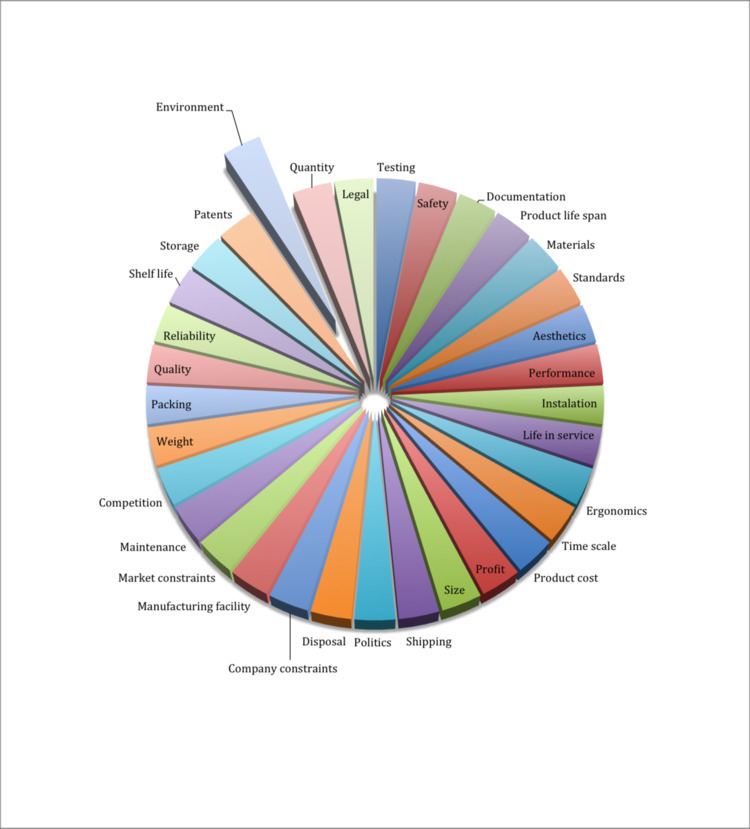 | ||
Design for the Environment (DfE) is a design approach to reduce the overall human health and environmental impact of a product, process or service, where impacts are considered across its life cycle. Different software tools have been developed to assist designers in finding optimized products or processes/services. DfE is also the original name of a United States Environmental Protection Agency (EPA) program, created in 1992, that works to prevent pollution, and the risk pollution presents to humans and the environment. This program provides information regarding safer chemical formulations for cleaning and other products. This program was renamed EPA Safer Choice in 2015.
Contents
- Introduction
- Design for Environment Practices
- Why do firms want to design for the environment
- Companies and Products
- How does a business design for the Environment
- Safer Product Labeling Program
- The National Ambient Air Quality Standards NAAQS
- Stratospheric Ozone Protection
- Reporting Requirements for Releases of Toxic Substances
- Other Regulations
- References
Introduction
Design for the Environment is a global movement targeting design initiatives and incorporating environmental motives to improve product design in order to minimize health and environmental impacts. The Design for the Environment (DfE) strategy aims to improve technology and design tactics to expand the scope of products. By incorporating eco-efficiency into design tactics, DfE takes into consideration the entire life-cycle of the product, while still making products usable but minimizing resource use. The key focus of DfE is to minimize the environmental-economic cost to consumers while still focusing on the life-cycle framework of the product. By balancing both customer needs as well as environmental and social impacts DfE aims to "improve the product use experience both for consumers and producers, while minimally impacting the environment".
Design for Environment Practices
Four main concepts that fall under the DfEt umbrella.
Life cycle assessment (LCA) is employed to forecast the impacts of different (production) alternatives of the product in question, thus being able to choose the most environmentally friendly. A life cycle analysis can serve as a tool when determining the environmental impact of a product or process. Proper LCAs can help a designer compare several different products according to several categories, such as energy use, toxicity, acidification, CO2 emissions, ozone depletion, resource depletion and many others. By comparing different products, designers can make decisions about which environmental hazard to focus on in order to make the product more environmentally friendly.
Why do firms want to design for the environment?
Modern day businesses all aim to produce goods at a low cost while maintaining quality, staying competitive in the global marketplace, and meeting consumer preferences for more environmentally friendly products. To help businesses meet these challenges, EPA encourages businesses to incorporate environmental considerations into the design process. The benefits of incorporating DfE include: cost savings, reduced business and environmental risks, expanded business and market opportunities, and to meet environmental regulations.
Companies and Products
Besides these large brand names there are several other consumer product companies in the DfE program this including:
How does a business design for the Environment?
A business can design for the environment by:
Safer Product Labeling Program
The U.S. Environmental Protection Agency DfE labeling program was renamed EPA Safer Choice in 2015.
The National Ambient Air Quality Standards (NAAQS)
The EPA has imposed the National Ambient Air Quality Standards (NAAQS) to establish an air quality standard across the U.S. The NAAQS sets standards on six main sources of pollutants, which include emissions of: ozone (0.12 ppm per 1 hour), carbon monoxide (35 ppm per 1 hour), pollutant (primary standards), particulate matter (50g/m^3 at an annual arithmetic mean), sulfur dioxide (80g/m^3 at an annual arithmetic mean), nitrogen dioxide (100g/m^3 at an annual arithmetic mean), and lead emissions (1.5g/m^3 at an annual arithmetic mean).
Stratospheric Ozone Protection
The Stratospheric Ozone Protection is under section 602 of the Clean Air Act of 1990. This regulation aims to decrease emission of chlorofluorocarbons (CFCs) and other chemicals that are destroying the stratospheric ozone layer. The protection initiative categorizes ozone-depleting substances into two classes: Class I, and Class II.
Class I substances include 20 different kinds of chemicals and have all been phased-out of production processes since 2000. Class II substances consist of the 33 different HCFCs. The EPA has already begun plans to decrease emissions in HCFCs and plan to completely phase out the class II substances by 2030.
Reporting Requirements for Releases of Toxic Substances
A firm operating in the electronics industry in SIC Codes 20-39 that has more than 10 full-time employees and consumes more than 10,000 lbs per year of any toxic chemical lists in 40 CFR 372.65 must file a toxic release inventory.
